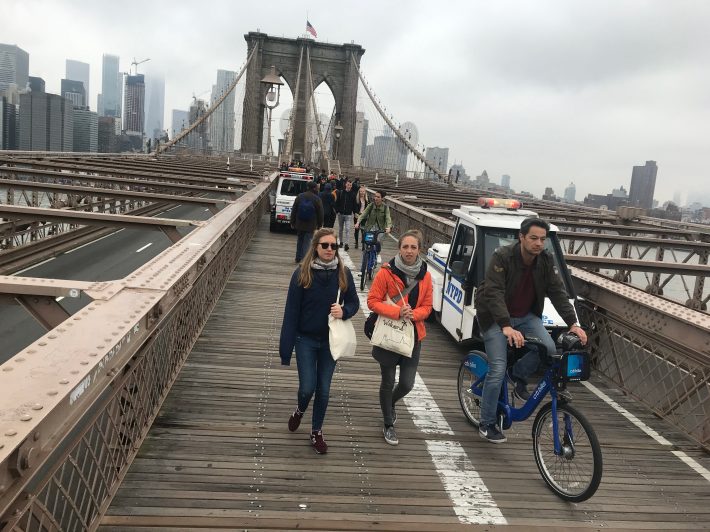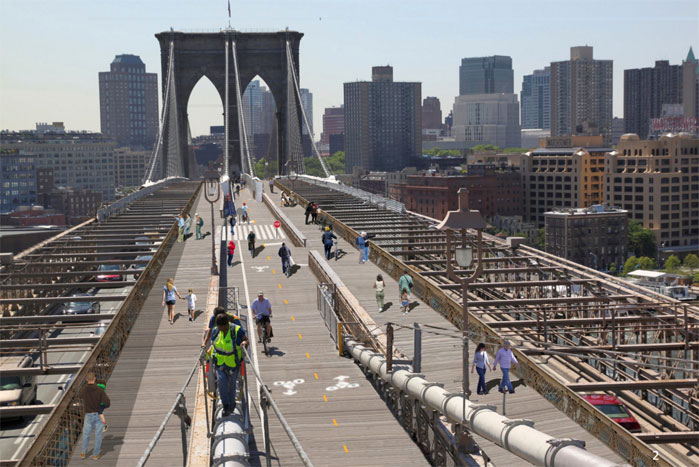The Department of Transportation, which has for years failed to fix dangerous and congested conditions on the shared foot and bike path on the Brooklyn Bridge, hinted on Thursday night that it might now consider a bike lane on the roadbed of the fabled span itself -- though it's unclear how seriously anyone should take the prospect, given that the agency's commissioner dismissed it out of hand only a few months ago.
DOT community liaison Emily Riquelme told members of Brooklyn Community Board 2 that the agency might soon announce "a study about the feasibility of a bikeway on the mainline of the Brooklyn Bridge."

The comments, first reported by the Brooklyn Paper, are the first hint that the agency might be reconsidering its long-standing aversion to a redesign of the roadway itself. It also adds a new plot twist to a long-running soap opera centered around the agencies inability to figure out what to do with a massive crowds of tourists and commuter cyclist who rely on the bridge's extremely narrow shared path.
The agency had previously said that it was looking at expanding the current pedestrian/cycling promenade, but that it had to finish a cable inspection before determining whether the plan was workable. In 2017, the agency announced the cable study would start in 2019 and last for two years, but earlier this year, DOT commissioner Polly Trottenberg revealed that it had failed to begin the study, and said the study would finally be completed this June.
It appears that the study has healed its first spoiled fruit: Riquelme told CB2 that a study for a pedestrian walkway on the Brooklyn Bridge was found to be unfeasible (though it is unclear if she was referring to the cable inspection study or some other study).
Trottenberg at one time said that taking a lane of car traffic from the bridge and giving it to cyclists was too difficult from both a safety and traffic perspective. The commissioner said that traffic modeling around removing a car lane on the Brooklyn Bridge "showed it produced pretty extraordinary traffic back-ups that made their way through the whole network of downtown Brooklyn" in 2017, and that an attractive lane for cyclists would be a difficult fit on the bridge.
The DOT also did not respond to a question as to whether the agency's thinking around the bridge's traffic patterns has changed to the point where a new study could show putting a bike lane on the roadbed would be feasible, nor did it respond to a question on what the timeframe for this study would be.
But the DOT isn't the only entity looking at ways to improve the pedestrian and cyclist experience on the Brooklyn Bridge. City Council Speaker Corey Johnson launched a redesign competition with the Van Alen Institute this year that encouraged the public to submit its best ideas to improve the promenade and even the road on the bridge. Architect John Massengale took the prompt and suggested a completely car-free Brooklyn Bridge, which he suggested could also be used to pave the way for parks and housing on the Brooklyn side of the bridge.
I made a study. If we make it an #OpenStreet, #CarFree Brooklyn Bridge, motor vehicle traffic will decrease by 100%, bicycle traffic might increase more than 1100%, and there will be twice as many pedestrians as on the High Line. https://t.co/FVlZrPXBmP
— John Massengale AIA CNU 🚶♀️🚶🚶♂️🚴♂️🇺🇦 (@jmassengale) June 19, 2020
And even before Riquelme told CB2 to stand by for an announcement of some time, a coalition including Transportation Alternatives, Bike New York and Streetsblog parent company Open Plans, sent the DOT a letter asking it to consider opening a lane of the Brooklyn Bridge and Queensboro Bridge.
"We need a plan to open vehicle lanes to cyclists, while maintaining existing shared facilities exclusively for pedestrians," the coalition wrote in its letter sent on June 17, in which the group pointed out that an increase of bike traffic was going to collide with a return of pedestrian traffic on the narrow shared spaces on both bridges.
Mayor de Blasio has just over 18 months left in office, and the cash-strapped city has already cut cycling programs from the budget. That leaves precious little time for a useful study, much less any action the city can take after it's completed.
"Whatever’s going on, if it’s subject to more study then it will run out the clock on the de Blasio administration," said Bike New York spokesman Jon Orcutt.






